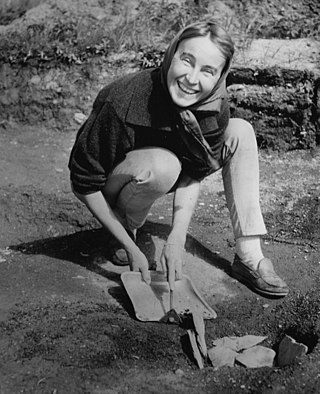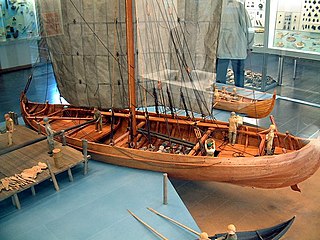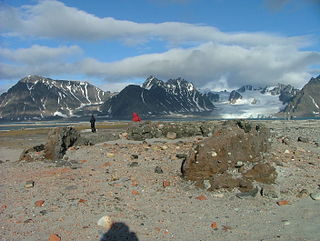Related Research Articles

Leif Erikson, also known as Leif the Lucky, was a Norse explorer who is thought to have been the first European to set foot on continental America, approximately half a millennium before Christopher Columbus. According to the sagas of Icelanders, he established a Norse settlement at Vinland, which is usually interpreted as being coastal North America. There is ongoing speculation that the settlement made by Leif and his crew corresponds to the remains of a Norse settlement found in Newfoundland, Canada, called L'Anse aux Meadows, which was occupied approximately 1,000 years ago.

Helge Marcus Ingstad was a Norwegian explorer. In 1960, after mapping some Norse settlements, Ingstad and his wife archaeologist Anne Stine Ingstad found remnants of a Viking settlement in L'Anse aux Meadows in the province of Newfoundland in Canada. They were thus the first to prove conclusively that the Icelandic/Greenlandic Norsemen such as Leif Erickson had found a way across the Atlantic Ocean to North America, roughly 500 years before Christopher Columbus and John Cabot. He also thought that the mysterious disappearance of the Greenland Norse Settlements in the 14th and 15th centuries could be explained by their emigration to North America.
Archaeology is the study of human activity in the past, primarily through the recovery and analysis of the material culture and environmental data that they have left behind, which includes artifacts, architecture, biofacts and cultural landscapes.

Anne Stine Ingstad was a Norwegian archaeologist who, along with her husband explorer Helge Ingstad, discovered the remains of a Norse settlement at L'Anse aux Meadows in the Canadian province of Newfoundland and Labrador in 1960.
The year 1968 in archaeology involved some significant events.
This page lists major events of 2001 in archaeology.
The year 1997 in archaeology involved some significant events.
The year 1961 in archaeology involved some significant events.
Below are notable events in archaeology that occurred in 1906.

The Vinland Sagas are two Icelandic texts written independently of each other in the early 13th century—The Saga of the Greenlanders and The Saga of Erik the Red. The sagas were written down between 1220 and 1280 and describe events occurring around 970–1030.

A knarr is a type of Norse merchant ship used by the Vikings for long sea voyages and during the Viking expansion. The knarr was a cargo ship; the hull was wider, deeper and shorter than a longship, and could take more cargo and be operated by smaller crews. It was primarily used to transport trading goods like walrus ivory, wool, timber, wheat, furs and pelts, armour, slaves, honey, and weapons. It was also used to supply food, drink, weapons and armour to warriors and traders along their journeys across the Baltic, the Mediterranean and other seas. Knarrs routinely crossed the North Atlantic carrying livestock such as sheep and horses, and stores to Norse settlements in Iceland, Greenland and Vinland as well as trading goods to trading posts in the British Isles, Continental Europe and possibly the Middle East. The knarr was constructed using the same clinker-built method as longships, karves, and faerings.

Spolia are stones taken from an old structure and repurposed for new construction or decorative purposes. It is the result of an ancient and widespread practice (spoliation) whereby stone that has been quarried, cut and used in a built structure is carried away to be used elsewhere. The practice is of particular interest to historians, archaeologists and architectural historians since the gravestones, monuments and architectural fragments of antiquity are frequently found embedded in structures built centuries or millennia later. The archaeologist Philip A. Barker gives the example of a late Roman period tombstone from Wroxeter that could be seen to have been cut down and undergone weathering while it was in use as part of an exterior wall and, possibly as late as the 5th century, reinscribed for reuse as a tombstone.
Cyril Alexander Mango was a British scholar of the history, art, and architecture of the Byzantine Empire. He is celebrated as one of the leading Byzantinists of the 20th century.

Aztec architecture is a late form of Mesoamerican architecture developed by the Aztec civilization. Much of what is known about this style of architecture comes from the structures that are still standing. These structures have survived for several centuries because of the strong materials used and the skill of the builders. Most civic architecture was concentrated in the center of Aztec cities. However, many cities had smaller supplemental ceremonial areas.

The Coatlicue statue is one of the most famous surviving Aztec sculptures. It is a 2.52 metre (8.3 ft) tall andesite statue by an unidentified Mexica artist. Although there are many debates about what or who the statue represents, it is usually identified as the Aztec deity Coatlicue ("Snakes-Her-Skirt"). It is currently located in the National Museum of Anthropology in Mexico City. Originally displayed in the Mexica city of Tenochtitlan, the monumental statue was buried after the 1521 Spanish conquest of the city, and it was excavated roughly 270 years later in 1790.

L'Anse aux Meadows is an archaeological site, first excavated in the 1960s, of a Norse settlement dating to approximately 1,000 years ago. The site is located on the northernmost tip of the island of Newfoundland in the Canadian province of Newfoundland and Labrador near St. Anthony.
Dibsi Faraj is an archaeological site on the right bank of the Euphrates in Aleppo Governorate (Syria). The site was excavated as part of a larger international effort coordinated by UNESCO to excavate as many archaeological sites as possible in the area that would be flooded by the reservoir created by the Tabqa Dam, which was being built at that time. An initial, small archaeological sounding was done at Dibsi Faraj by the Syrian Department of Antiquities in 1971. Following this investigation, the site was excavated between 1972 and 1974 as part of a joint operation of the Dumbarton Oaks Center for Byzantine Studies and the Kelsey Museum of Archaeology at the University of Michigan under the direction of Richard P. Harper. Since then, the site has disappeared under the rising waters of Lake Assad, the reservoir created by the Tabqa Dam.
The Monastery of the Virgins is a structure uncovered during Benjamin Mazar's excavations south of Jerusalem's Temple Mount. The large number of Christian religious finds from the site have prompted its identification with a monastery described by a pilgrim, Theodosius the archdeacon, in his De Situ Terrae Sanctae, a work of the early 6th century. The building was constructed in the 4th century on the remains of an earlier Herodian building identified with the Second Temple courthouse, and was destroyed during the Persian sack of Jerusalem in 614.

The archaeology of Svalbard is the study of human activity in the northerly Arctic Ocean archipelago's past. The geography, environment and climate of Svalbard have resulted in exceptional preservation conditions. Archaeological fieldwork on Svalbard is both expensive and physically exhausting, but new technology and infrastructure has allowed easier access. This easier access has also resulted in more damage caused by tourists.
References
- ↑ Radford, David (2018). The Archaeology of Oxford in 20 digs. Stroud: Amberley Publishing. pp. 12–15. ISBN 978-1-4456-8085-9.
- ↑ Kelly, John (13 January 2014). "Local Intriguing story behind a stone figure at Dumbarton Oaks". The Washington Post . Retrieved 12 August 2015.
- ↑ "Helge Marcus Ingstad". Encyclopedia Britannica. Retrieved 8 February 2019.